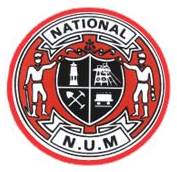Related Research Articles

The National Union of Mineworkers (NUM) is a trade union for coal miners in Great Britain, formed in 1945 from the Miners' Federation of Great Britain (MFGB). The NUM took part in three national miners' strikes, in 1972, 1974 and 1984–85. After the 1984–85 strike and the subsequent closure of most of Britain's coal mines, it became a much smaller union. It had around 170,000 members when Arthur Scargill became leader in 1981, a figure which had fallen in 2015 to an active membership of around 100.
The Union of Democratic Mineworkers (UDM) is a British trade union for coal miners based in Nottinghamshire, England. Established in 1985 after a constitutional crisis in the National Union of Mineworkers, the UDM was given its certification on 6 December 1985, although it had effectively been in existence since the Nottinghamshire area of the NUM voted to secede from the federal union on 6 July 1985. After the events of the strike in 1984-5, the Nottinghamshire area of the NUM was involved in a number of disputes with the National Executive Committee that led to a ballot in May on empowering the Nottingham Area Committee to disassociate from the NUM. In ballots on 18 and 19 October on joining with Nottinghamshire in a new union, the South Derbyshire area of the NUM voted in favour by 51% and the Colliery Workers and Allied Trades Association voted in favour by almost 100%.
The Miners' Federation of Great Britain (MFGB) was established after a meeting of local mining trade unions in Newport, Wales in 1888. The federation was formed to represent and co-ordinate the affairs of local and regional miners' unions in England, Scotland and Wales whose associations remained largely autonomous. At its peak, the federation represented nearly one million workers. It was reorganised into the National Union of Mineworkers in 1945.

The South Wales Miners' Federation (SWMF), nicknamed "The Fed", was a trade union for coal miners in South Wales. It survives as the South Wales Area of the National Union of Mineworkers.

The Yorkshire Miners' Association was a British trade union. It is now an integral part of the National Union of Mineworkers (NUM).

The Nottinghamshire Miners' Association was a trade union representing coal miners in Nottinghamshire, in England.
William Ernest Jones, CBE was a British trade unionist.

The Derbyshire Miners' Association was a trade union in the United Kingdom.

The Leicestershire Miners' Association was a trade union in the United Kingdom.
The Cumberland Miners' Association was a trade union in the United Kingdom.
The North Wales Miners' Association was a trade union representing coal miners in Wales.
The UK miners' strike of 1969 was an unofficial strike that involved 140 of the 307 collieries owned by the National Coal Board, including all collieries in the Yorkshire area. The strike began on 13 October 1969 and lasted for roughly two weeks, with some pits returning to work before others. The NCB lost £15 million and 2.5 million tonnes of coal as a result of the strike.
The Bristol Miners' Association was a trade union representing coal miners in Bristol and Bedminster in England.
The Mid and East Lothian Miners' Association (MELMA) was a trade union representing coal miners in parts of the Lothian area of Scotland.
Nicky Wilson is a British trade unionist.
The Miners' National Union (MNU) was a trade union which represented miners in Great Britain.

The National Union of Cokemen and By-product Workers was a trade union representing workers involved in turning coal into coke at collieries in Great Britain. It survives today as the Cokemen's Area of the National Union of Mineworkers.
The Warwickshire Miners' Association was a trade union representing coal miners in the Warwickshire area of England.
The Cannock Chase Miners', Enginemen's and Surfacemen's Association was a trade union representing coal miners in the Cannock Chase area of England.
The North Staffordshire Miners' Federation was a trade union representing miners in the area of Stoke-on-Trent, located in Staffordshire, in England.
References
- ↑ Page Arnot, Robin (1949). The Miners. Allen & Unwin.
- 1 2 3 Smethurst, John B.; Carter, Peter (June 2009). Historical Directory of Trade Unions. 6. Farnham: Ashgate Publishing. pp. 504, 512. ISBN 9780754666837. LCCN 80-151653.
- ↑ "Miners' Conference at Newport" . The Manchester Guardian . 27 November 1889. Retrieved 6 April 2016– via ProQuest.